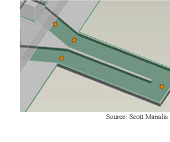|
NEWS
|
Liquid scale
 A tiny scale made from a cantilever with a built-in
microfluidic channel measures the mass of individual cells
and biological molecules in liquid. The device could be
used in biochips to detect pathogens and diagnose diseases.
(Weighing
of Biomolecules, Single Cells and Single Nanoparticles
in Fluid, Nature, April 26, 2007)
A tiny scale made from a cantilever with a built-in
microfluidic channel measures the mass of individual cells
and biological molecules in liquid. The device could be
used in biochips to detect pathogens and diagnose diseases.
(Weighing
of Biomolecules, Single Cells and Single Nanoparticles
in Fluid, Nature, April 26, 2007)
Power placemats
A flexible sheet of plastic electronic circuits
powers electronic devices placed on or near the sheet.
The sheets could be used to cover desks and walls to power
lights and recharge cell phones. (A
Large-Area Wireless Power-Transmission Sheet Using Printed
Organic Transistors and Plastic MEMS Switches, Nature
Materials, published online April 29, 2007)
Faster to the fastest
Working from the notion that you start a trip
to a particular destination via one of only a few initial
intersections, researchers have developed an algorithm
for determining the quickest route through a network of
roads that is about 100 times faster than previous algorithms.
The technique could be extended to speed routing algorithms
for the Internet and other networks as well as roads.
(Fast
Routing in Road Networks with Transit Nodes, Science,
April 27, 2007)
Quantum crypto cracked
An experimental eavesdropping attack successfully
compromised a quantum cryptography system. The attack,
carried out in laboratory conditions, could help researchers
determine the limits of a standard quantum cryptography
protocol. (Complete
Physical Simulation of the Entangling-Probe Attack on
the Bennett-Brassard 1984 Protocol, Physical Review
A, April 2007)
Quantum nano ratchet
A theoretical study shows that patterned metal
surfaces placed nanometers apart can be made to slide
past each other in a ratchet-fashion simply from the quantum
fluctuations that occur naturally in a vacuum. The technique
could be used to power nanoscale machines. (Casimir-Force-Driven
Ratchets, Physical Review Letters, April 20,
2007)
Nano MRI closer
The latest prototype hybrid magnetic resonance-atomic
force microscope imaging system has a spatial resolution
of about 90 nanometers, an improvement of more than four
orders of magnitude over the highest-resolution MRI system.
The prototype brings MRI technology a step closer to imaging
individual molecules within biological samples. (Nuclear
Magnetic Resonance Imaging with 90-nm Resolution,
Nature Nanotechnology, published online April 22,
2007) |
FEATURES
|
View
from the High Ground: ICL's John Pendry
Physics as machine tool, negative refractive
index, metamaterials, shattered wine glasses, higher capacity
DVDs, scientific backwaters, risk perception and practice,
practice, practice.
|
How
It Works: Quantum computing: qubits
Photons, electrons and atoms, oh my! These particles are
the raw materials for qubits, the basic building blocks
of quantum computers. |
|
 |
News RSS feed 
Blog RSS feed 
Bookshelf RSS feed

New: TRN's
Internet Services
TRN's Jobs Center
|
| |
|
| |
|
| |
"Physics
is to the rest of science what machine tools are
to engineering. A corollary is that science places
power in our hands which can be used for good or
ill. Technology has been abused in this way throughout
the ages from gunpowder to atomic bombs."
- John Pendry, Imperial College London |
|
| |
|
| |
Thanks
to Kevin from
GoldBamboo.com
for technical support |
|

